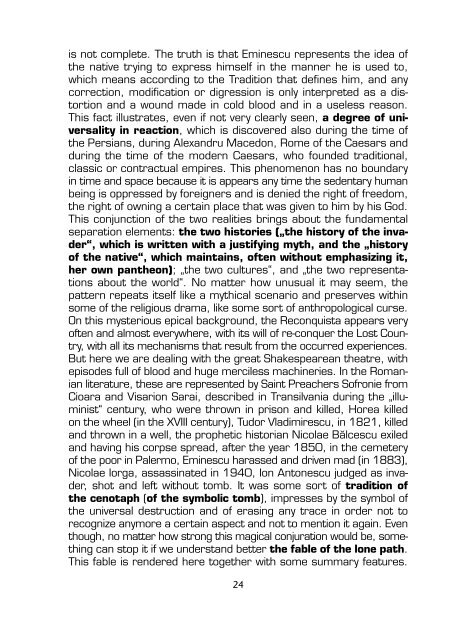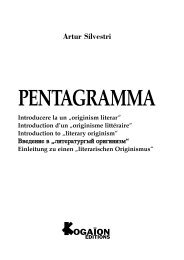genius loci pt. pdf.qxd - ROMANIAN LIBRARY
genius loci pt. pdf.qxd - ROMANIAN LIBRARY
genius loci pt. pdf.qxd - ROMANIAN LIBRARY
You also want an ePaper? Increase the reach of your titles
YUMPU automatically turns print PDFs into web optimized ePapers that Google loves.
is not complete. The truth is that Eminescu represents the idea of<br />
the native trying to express himself in the manner he is used to,<br />
which means according to the Tradition that defines him, and any<br />
correction, modification or digression is only interpreted as a distortion<br />
and a wound made in cold blood and in a useless reason.<br />
This fact illustrates, even if not very clearly seen, a degree of universality<br />
in reaction, which is discovered also during the time of<br />
the Persians, during Alexandru Macedon, Rome of the Caesars and<br />
during the time of the modern Caesars, who founded traditional,<br />
classic or contractual empires. This phenomenon has no boundary<br />
in time and space because it is appears any time the sedentary human<br />
being is oppressed by foreigners and is denied the right of freedom,<br />
the right of owning a certain place that was given to him by his God.<br />
This conjunction of the two realities brings about the fundamental<br />
separation elements: the two histories („the history of the invader“,<br />
which is written with a justifying myth, and the „history<br />
of the native“, which maintains, often without emphasizing it,<br />
her own pantheon); „the two cultures“, and „the two representations<br />
about the world“. No matter how unusual it may seem, the<br />
pattern repeats itself like a mythical scenario and preserves within<br />
some of the religious drama, like some sort of anthropological curse.<br />
On this mysterious epical background, the Reconquista appears very<br />
often and almost everywhere, with its will of re-conquer the Lost Country,<br />
with all its mechanisms that result from the occurred experiences.<br />
But here we are dealing with the great Shakespearean theatre, with<br />
episodes full of blood and huge merciless machineries. In the Romanian<br />
literature, these are represented by Saint Preachers Sofronie from<br />
Cioara and Visarion Sarai, described in Transilvania during the „illuminist“<br />
century, who were thrown in prison and killed, Horea killed<br />
on the wheel (in the XVIII century), Tudor Vladimirescu, in 1821, killed<br />
and thrown in a well, the prophetic historian Nicolae Bãlcescu exiled<br />
and having his corpse spread, after the year 1850, in the cemetery<br />
of the poor in Palermo, Eminescu harassed and driven mad (in 1883),<br />
Nicolae Iorga, assassinated in 1940, Ion Antonescu judged as invader,<br />
shot and left without tomb. It was some sort of tradition of<br />
the cenotaph (of the symbolic tomb), impresses by the symbol of<br />
the universal destruction and of erasing any trace in order not to<br />
recognize anymore a certain aspect and not to mention it again. Even<br />
though, no matter how strong this magical conjuration would be, something<br />
can stop it if we understand better the fable of the lone path.<br />
This fable is rendered here together with some summary features.<br />
24



